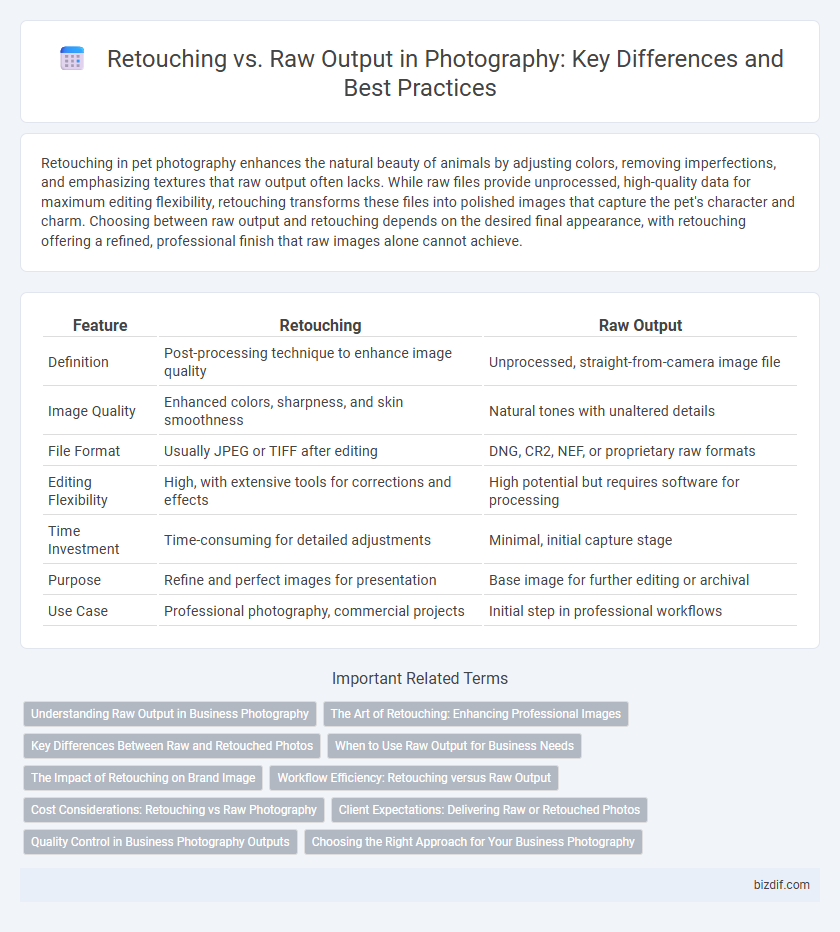Retouching in pet photography enhances the natural beauty of animals by adjusting colors, removing imperfections, and emphasizing textures that raw output often lacks. While raw files provide unprocessed, high-quality data for maximum editing flexibility, retouching transforms these files into polished images that capture the pet's character and charm. Choosing between raw output and retouching depends on the desired final appearance, with retouching offering a refined, professional finish that raw images alone cannot achieve.
Table of Comparison
| Feature | Retouching | Raw Output |
|---|---|---|
| Definition | Post-processing technique to enhance image quality | Unprocessed, straight-from-camera image file |
| Image Quality | Enhanced colors, sharpness, and skin smoothness | Natural tones with unaltered details |
| File Format | Usually JPEG or TIFF after editing | DNG, CR2, NEF, or proprietary raw formats |
| Editing Flexibility | High, with extensive tools for corrections and effects | High potential but requires software for processing |
| Time Investment | Time-consuming for detailed adjustments | Minimal, initial capture stage |
| Purpose | Refine and perfect images for presentation | Base image for further editing or archival |
| Use Case | Professional photography, commercial projects | Initial step in professional workflows |
Understanding Raw Output in Business Photography
Raw output in business photography captures uncompressed, unprocessed image data directly from the camera sensor, preserving maximum detail and dynamic range for enhanced editing flexibility. This format enables photographers to maintain control over exposure, color balance, and sharpness, essential for producing polished, professional visuals that meet client specifications. Understanding raw output allows businesses to achieve superior image quality and consistency, optimizing brand representation across marketing materials.
The Art of Retouching: Enhancing Professional Images
Retouching transforms raw images by adjusting exposure, color balance, and removing imperfections to create polished photographs that meet professional standards. Skilled retouching preserves natural details while enhancing visual appeal, contrasting the untouched raw output which serves as the foundational data. This artful process elevates the overall quality, ensuring images convey the desired aesthetic and emotional impact.
Key Differences Between Raw and Retouched Photos
Raw photos capture unprocessed sensor data with maximum dynamic range and detail, serving as a digital negative that provides extensive editing flexibility. Retouched photos undergo post-processing adjustments such as color correction, exposure enhancement, and blemish removal to optimize visual appeal and artistic intent. The key differences lie in raw files being untouched originals ideal for detailed manipulation, while retouched images deliver polished, finalized versions ready for display or publication.
When to Use Raw Output for Business Needs
Raw output retains maximum image data, offering superior flexibility for high-quality prints and professional editing, essential for businesses requiring precise color correction and detailed adjustments. Utilizing raw files enables photographers to deliver consistent branding through customized post-processing that aligns with client specifications. Choosing raw output is particularly beneficial in commercial photography sectors, such as advertising and product imaging, where image integrity directly impacts brand perception and sales.
The Impact of Retouching on Brand Image
Retouching enhances photographs by correcting imperfections, adjusting colors, and refining details, significantly influencing a brand's visual identity and perceived professionalism. High-quality retouching ensures consistency across all images, reinforcing brand recognition and appealing to target audiences. Conversely, relying solely on raw output may convey an unpolished image, potentially undermining brand credibility and market positioning.
Workflow Efficiency: Retouching versus Raw Output
Retouching enhances workflow efficiency by allowing photographers to correct imperfections and fine-tune images quickly, ensuring consistent visual quality across a batch of photos. Raw output preserves the maximum amount of image data, offering flexibility for extensive adjustments but often requiring more processing time and expertise. Balancing retouching and raw file management streamlines post-production and optimizes overall productivity in photography projects.
Cost Considerations: Retouching vs Raw Photography
Retouching photography involves additional costs for software licenses like Adobe Photoshop or Lightroom, as well as the time investment required for skilled editing, which can increase overall expenses. Raw output offers a cost-effective solution by providing high-quality images with maximum data, allowing photographers to make selective adjustments without extensive post-processing. Balancing these costs is critical for businesses or individuals aiming to optimize their budget while maintaining professional image quality.
Client Expectations: Delivering Raw or Retouched Photos
Delivering retouched photos meets client expectations for polished, high-quality images that showcase professional enhancements such as color correction, skin smoothing, and background adjustments. Raw output appeals to clients who prefer full control over post-processing or require unaltered files for their own editing purposes. Clear communication about the scope of retouching services ensures alignment with client needs and satisfaction.
Quality Control in Business Photography Outputs
Retouching in business photography enhances image quality by correcting imperfections, adjusting colors, and refining details, ensuring a polished and professional final product. Raw output maintains the original data captured by the camera sensor, offering maximum flexibility for post-processing but often requiring more time and expertise to achieve desired quality standards. Effective quality control balances the precision of retouching with the authenticity of raw files to deliver consistent, high-quality images that meet client expectations.
Choosing the Right Approach for Your Business Photography
Selecting between retouching and raw output depends on the desired presentation and client expectations in business photography. Retouching enhances images through color correction, blemish removal, and compositing to achieve polished, professional results that align with brand identity. Raw output preserves original data, offering flexibility for future edits but may lack the finished aesthetic necessary for marketing and corporate materials.
Retouching vs Raw Output Infographic

 bizdif.com
bizdif.com